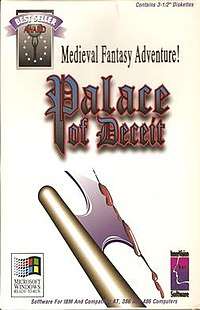The Palace of Deceit
| The Palace of Deceit | |
|---|---|
 1992 Cover art | |
| Developer(s) | Cliff Bleszinski |
| Publisher(s) |
Atomic Revolution Software (1991) Game Syndicate Productions (1992) InnerVision Software (1992) |
| Designer(s) | Cliff Bleszinski |
| Programmer(s) | Cliff Bleszinski |
| Artist(s) | Cliff Bleszinski |
| Platform(s) | DOS, Windows 3.x |
| Release |
1991 (DOS) August 31, 1992 (Windows) |
| Genre(s) | Adventure |
| Mode(s) | Single-player |
Palace of Deceit is a video game independently coded, designed, composed and developed by Cliff Bleszinski in 1991 in his own company Game Syndicate Productions at the age of 17.[1] The first edition subtitled The Secret of Castle Lockemoer was a text adventure for DOS. On August 31, 1992, it was remade for Windows 3.x and subtitled The Dragon's Plight as a graphical point-and-click adventure game with an entirely new plot and graphics. Both games are played in a first-person perspective and have been released as freeware. Cliff's inspiration came from video games like Déjà Vu and Uninvited.[2]
The Secret of Castle Lockemoer
In the original game, the player has the role of a man from the future brought to the medieval past by a good wizard to enter the castle Lockemoer and destroy the Evil Wizard. The game is a text adventure which uses occasional graphics which are created using ASCII.
The Dragon's Plight
In this remake, the player has the role of the dragon Nightshade, who has been captured by the evil wizard Garth and thrown into the dungeons. Nightshade seeks a way out of the castle and a way to destroy Grath for his campaign to wipe out dragonkind from the land of Salac. The game is a point-and-click Adventure which has some similarities to Shadowgate and Déjà Vu, but it entirely lacks music and sound. Sometimes there are death encounters for the player so that the player will have to restart or load a saved game. The game was coded in Visual Basic.[3] The graphics were created using Windows Paint.[4]
References
- ↑ Jon Porter (July 22, 2017). "Cliff Bleszinski talks Lawbreakers and being the underdog to Overwatch". Future Publishing Limited. Retrieved July 4, 2018.
- ↑ Funk, Joe (2010). Hot Jobs in Video Games: Cool Careers in Interactive Entertainment. New York City, New York: Scholastic. ISBN 978-0-5452-1850-4.
- ↑ "Cliff Bleszinski Interview". September 14, 2012. Retrieved July 21, 2017.
- ↑ Eddy, Andy. "How Cliff Bleszinski went from bumming games to widespread fame". Retro. No. 4. p. 14.